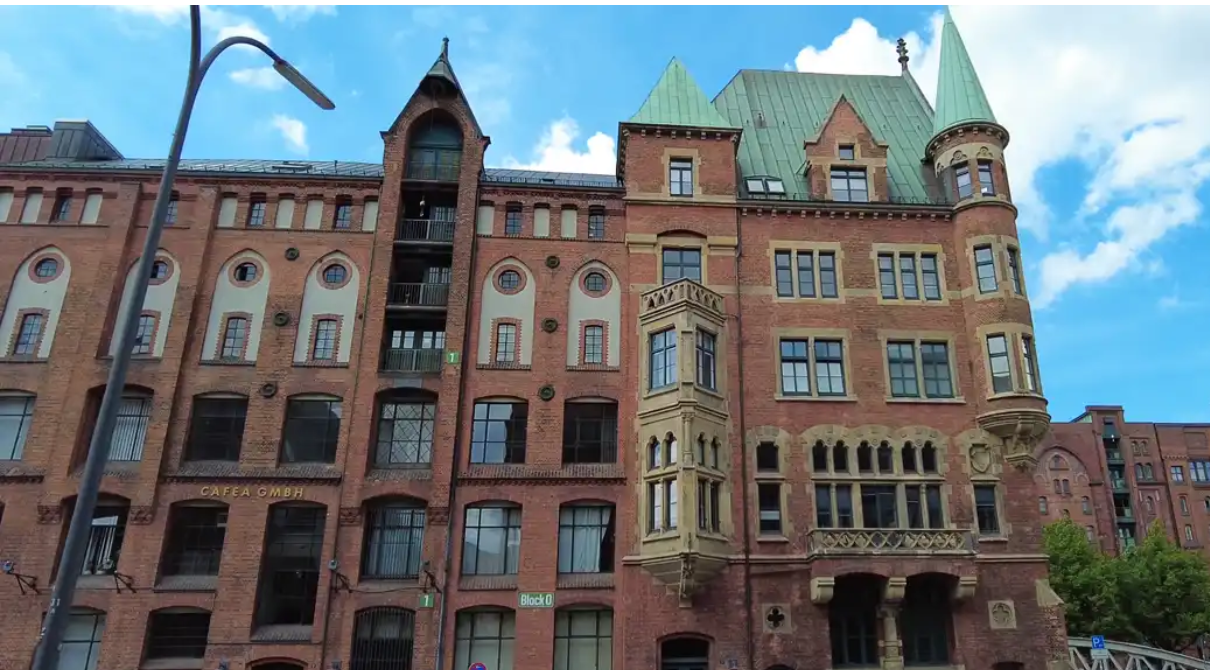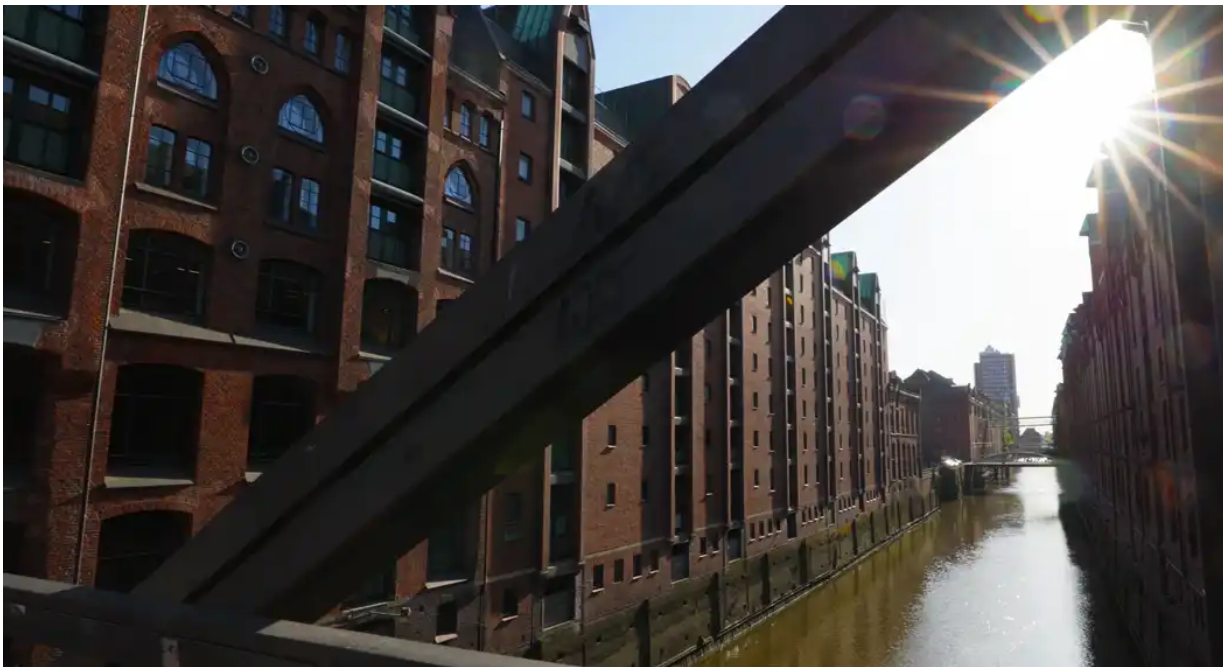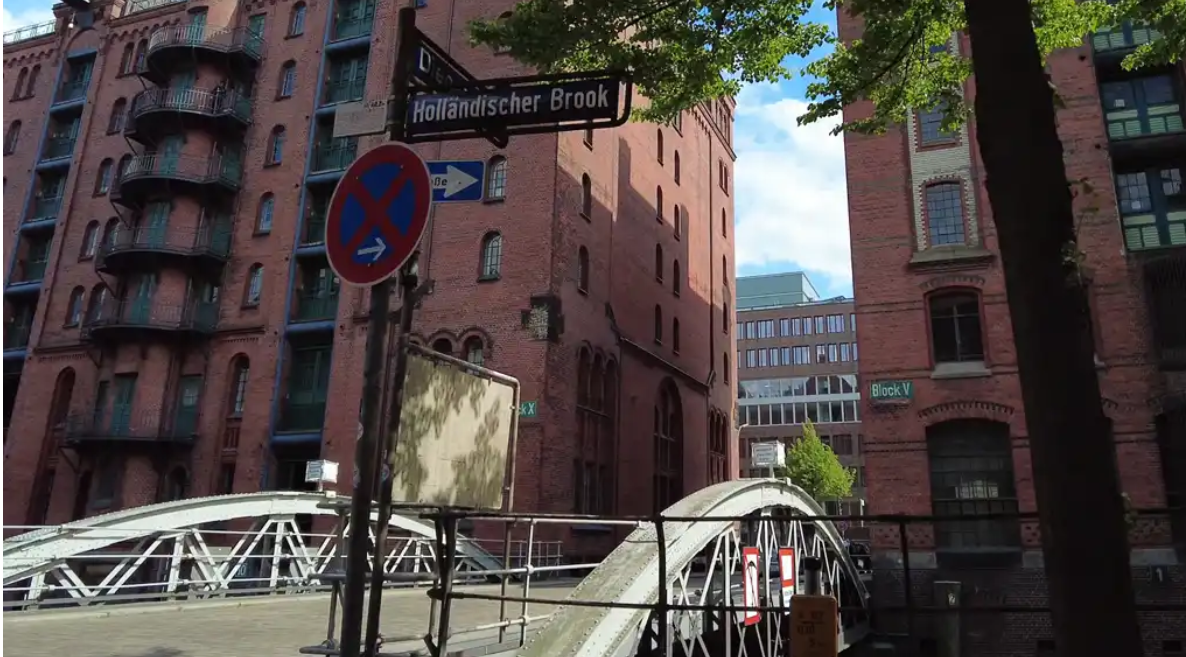A historic World Heritage Site with unique charm and maritime history
Address: Speicherstadt, Am Sandtorkai 37, 20457 Hamburg | Built: 1883 – 1927 | Area: approx. 26 hectares
The Speicherstadt in Hamburg is the largest warehouse complex in the world. Surrounded by water, the buildings rise several stories high into the sky. The historic brick buildings blend uniquely with the architecture of the modern glass and steel structures located in the immediate vicinity of the Speicherstadt. A stroll through the area reveals numerous special features and attractions. A great photo opportunity is the moated castle, located at the tip of the Dutch Brook.
Directions and location of the Hamburg warning sign
The Speicherstadt has been separated from the Free Port since January 1, 2003, which was dissolved in 2013. Since March 1, 2008, it has been administratively part of the HafenCity district in the Hamburg-Mitte district and the new development area located on Grosse Grasbrook.
The street Am Sandtorkai runs along the Speicherstadt, while the Zollkanal borders the other side of the warehouse complex. The Wandrahmsfleet canal is also part of the Speicherstadt. Those who want to explore the Speicherstadt can embark on a journey of discovery on foot or take a boat trip through the canals and waterways of the Speicherstadt with the harbor captains.
Opening Hours and Tours
The Speicherstadt can be visited at any time of day or night, as it is a publicly accessible area in Hamburg. Therefore, there are no set opening hours. However, anyone wishing to see the accessible, historic warehouses from the inside must adhere to specific opening hours, which vary depending on the building’s use.

FAQ – Frequently Asked Questions about the Speicherstadt in Hamburg
What is the Speicherstadt in Hamburg and why is it so famous?
The Speicherstadt in Hamburg is a UNESCO World Heritage Site and is the world’s largest historic warehouse complex with impressive architecture. The buildings, built of brick at the end of the 19th century, were used as duty-free warehouses for various trade goods. An ingenious network of canals crisscrosses the historic warehouse complex, creating a very special atmosphere.
What is particularly worth seeing in the Hamburg Speicherstadt?
Special attractions in the Speicherstadt include the Miniatur Wunderland, the German Customs Museum, the Hamburg Dungeon, and the Speicherstadt Museum, which offer a chance to delve into the past of the historic Hamburg warehouse complex.
What architectural features does the Speicherstadt offer?
The warehouses, built of brick, reflect the neo-Gothic architectural style in a unique way. They feature ornate gables, turrets, and impressive wrought iron details. The warehouses were built on oak piles and are surrounded by canals.
What is the difference between the Speicherstadt and HafenCity?
HafenCity, built on former harbor land, is a modern urban development project, while the Speicherstadt, with its impressive warehouses, looks back on a long history. Interestingly, the two areas are spatially closely connected and have succeeded in creating a symbiosis of modernity and history.
What is the best time to visit the Speicherstadt?
The Speicherstadt is worth a visit year-round. The historic warehouses exude a special charm in the evenings when their facades are illuminated. In summer, you can enjoy a sunset in pleasantly warm temperatures on the outdoor terraces of the restaurants and cafés.
Speicherstadt – Special Features and Interesting Facts
There’s much to discover in Hamburg’s impressive Speicherstadt district. Not only the location, but also the buildings tell interesting and exciting stories. The moated castle, located at the end of the Holländischer Brook, is a popular photographic subject. The moated castle was built between 1905 and 1907 during the construction of the third phase. Today, the castle houses a restaurant and a tea shop.
The moated castle was the only building in the Speicherstadt that was permitted to be inhabited. This was intended to prevent smuggling in the Free Port area at the time. This regulation also ensured adequate protection for the Speicherstadt in the event of a storm surge hitting Hamburg.
Another popular photo subject is the Fleetschlösschen (little fleet castle), located on Brooktorkai. The building has had many uses over the years, including as a fire station, a customs building, and even a public restroom. Another exciting building in the Speicherstadt is located at Kehrwiederspitze, which houses the Water Police station. The building was constructed in 1902 and is familiar to many from the television series “Notruf Hafenkante.”
The Speicherstadt stretches across approximately 26 hectares between Oberhafen and Baumwall. The warehouse complex was built on thousands of oak piles. The historic brick buildings date from 1883 to the late 1920s. Another special eye-catcher is the “Speicherstadtrathaus.” The building was built between 1902 and 1904. The design was by Johannes Grotjan, and the construction was carried out by the firm Hanßen & Meerwein. They also played a key role in the construction of Hamburg’s City Hall.
Because the then Chief Building Director, Andreas Meyer, had a particular fondness for the Hanover School of Architecture, the Speicherstadt was built using brick in the Gothic Revival style. Decorative gables, bay windows, and sandstone ornaments adorn the buildings. Great importance was placed on clean workmanship in the warehouses. This also applied to the exposed brickwork. Accents were added with lighter bricks and molded stones, creating a unique appearance.
The buildings are supported by an iron skeleton resting on wooden piles. This construction was used in the 1920s during the construction of the first skyscrapers in New York. Subsequently, the outer facade of the warehouses was clad in brick. Later, emergency exits were created on the waterfront in the form of a spiral staircase.
Inside the warehouses, in addition to staircases, there were hydraulic motors and shafts, and each storage block had up to eight storage floors. The warehouses were designed to prevent frost from penetrating. Therefore, the temperature inside never dropped below 18°C in winter. Winches were installed under the roof. Goods and wares could be transported through the hatches to the individual floors for storage.
The roads leading through the Speicherstadt were used by railways and wagons. Duty-free storage of goods was possible in the Speicherstadt. Duty was only payable upon leaving the area.

Historical Facts and History of the Speicherstadt
The Hamburg Speicherstadt was built between 1883 and 1927, creating a unique ensemble of brick warehouses in the neo-Gothic architectural style. The warehouse complex was inaugurated by Kaiser Wilhelm II and Bismarck.
At that time, there were several reasons for establishing the Speicherstadt in Hamburg. After the Franco-Prussian War, which took place between 1870 and 1871, Hamburg was a duty-free zone. After the Hanseatic city joined the German Empire and the Customs Union, the duty-free zone was reduced and limited to the Grosser and Kleiner Grasbook. The city owes the preservation of the Free Port of Hamburg, and thus the duty-free storage and processing of goods, to Johannes Versmann, a Senator of Hamburg.
One reason for the construction of the Speicherstadt was to consolidate the individual warehouses located in Hamburg’s city center. To make this possible, the area south of the old town, comprising 26 hectares, was chosen in 1883. The Sandtorkai deep-sea port, which opened in 1866, already existed right next door.
The Speicherstadt was built on Kehrwieder and Wandrahm, two islands in the Elbe, creating a 250-meter-wide and 1.5-kilometer-long warehouse complex. The warehouse complex stretched from the Kehrwiederspitze to the so-called Teerhof. Today, the Hanseatic Trade Center is located at the Kehrwiederspitze.
Space had to be made for the construction of the Speicherstadt. For this, 24,000 people had to leave their homes, which were subsequently demolished. The residents themselves had to bear the costs of the forced relocation, unlike the owners of the buildings. In 1885, the people of Hamburg established the “Hamburg Freeport Warehouse Company” (HFLG) to build and manage the Speicherstadt.
Naturally, the ravages of time are also taking their toll on the old walls and oak piles on which the Speicherstadt was originally built. Therefore, renovation plans were drawn up. In the coming years, approximately €190 million will be made available for the repair of the warehouses.
The Speicherstadt is a listed building and is officially designated as Germany’s 40th UNESCO World Heritage Site, along with the Chilehaus and the neighboring Kontorhausviertel. What makes the Speicherstadt special is that it symbolizes human history in several phases.

Sights and attractions in the immediate vicinity of the Speicherstadt
To discover interesting sights and attractions, a stroll through the Speicherstadt is enough. The buildings house fascinating museums that are definitely worth a visit.
A museum tour in the Speicherstadt offers a variety of experiences. The Speicherstadt Museum is a must. The history of customs and smuggling in the Port of Hamburg is presented in a unique way at the German Customs Museum, while the International Maritime Museum displays numerous ship models and nautical charts. At the Prototyp Automuseum, you can admire high-performance rarities from the 70-year history of the automobile.
An exciting experience in the Speicherstadt is a visit to the coffee roastery, located in a former original coffee warehouse. There, you can learn a lot about the world of coffee beans and enjoy a freshly brewed coffee at the same time. A stroll through the Speicherstadt along the canals automatically leads to the Sandtorhafen, where 20 historic ships are moored.
Another building worth discovering during a stroll is the former power plant at Am Sandtorkai, built for the newly constructed Speicherstadt (Warehouse District). This interesting industrial monument now serves as an exhibition space for HafenCity and the Speicherstadt.
For architecture enthusiasts, the symbiosis of historic walls and the modern buildings made of steel and concrete in HafenCity is certainly a special eye-catcher. It truly succeeds in building an impressive bridge between modernity and history.
Anyone who wants to experience a ghostly journey through Hamburg’s history should visit the Dungeon in the Speicherstadt. Visitors experience the Hanseatic city’s dangerous and gruesome past up close and encounter some sinister characters.
A boat trip through the Speicherstadt can provide a different perspective. Barges are available at the piers for this purpose.
Cafés and Restaurants Near the Speicherstadt
Hunger and thirst can be satisfied in and around the Speicherstadt. Numerous restaurants and cafés offer special delicacies. Guests are offered seasonal, regional, national, and international cuisine, so there’s something for everyone. Vegetarians and vegans are also catered for.
The Restaurant Schönes Leben is located directly in the Speicherstadt, at Alter Wandrahm 17. In the bright, cozy restaurant, guests are served coffee specialties as well as authentic Hamburg dishes such as North Sea plaice and pan-fried fish. When the weather is nice, the outdoor terrace is also open, allowing guests to enjoy the special atmosphere of the Speicherstadt.
Address: Restaurant Schönes Leben, Alter Wandrahm 17, 20457 Hamburg
The Fleetschlösschen by Daniel Wischer at Brooktorkai 17 is a quaint restaurant with brick walls and offers a unique ambiance. The kitchen prepares exclusive fish specialties for guests. In addition to draft beer, there is a fine selection of wines to perfectly complement the experience.
Address: Fleetschlösschen by Daniel Wischer, Brooktorkai 17, 20457 Hamburg
The Cantinetta Ristorante & Bar, Pickhuben 3, boasts a tasteful ambiance and a magnificent view of the canal. Guests can enjoy Italian coffee delicacies and exclusive rum. Italian pasta creations, antipasti, salads, giabatta, and other delicacies are freshly prepared in the kitchen. Lovingly presented and offering a great variety of flavors, they perfectly complement the experience.
Address: Cantinetta Ristorante & Bar, Pickhuben 3, 20457 Hamburg
The Chilli Club Restaurant, located at Am Sandtorkai 54, is a modern, minimalist restaurant with a bar, and guests can enjoy a direct view of the canal through its large glass frontage. The kitchen serves Asian dishes such as curries, delicious sushi, and tasty stir-fries made with fresh ingredients. The extensive drinks menu includes beer, wine, soft drinks, as well as cocktails and long drinks.
Address: Chilli Club Restaurant, Am Sandtorkai 54, 20457 Hamburg
Bianc
Those looking for something special will find what they’re looking for at Restaurant Bianc, located at Am Sandtorkai 50. The gourmet restaurant’s menu includes Mediterranean dishes as well as multi-course menus with perfectly matched flavors. There’s also a fine selection of wines. This modern restaurant, featuring wood and tile flooring, is a true feast for the palate.
Address: Restaurant Bianc, Am Sandtorkai 50, 20457 Hamburg